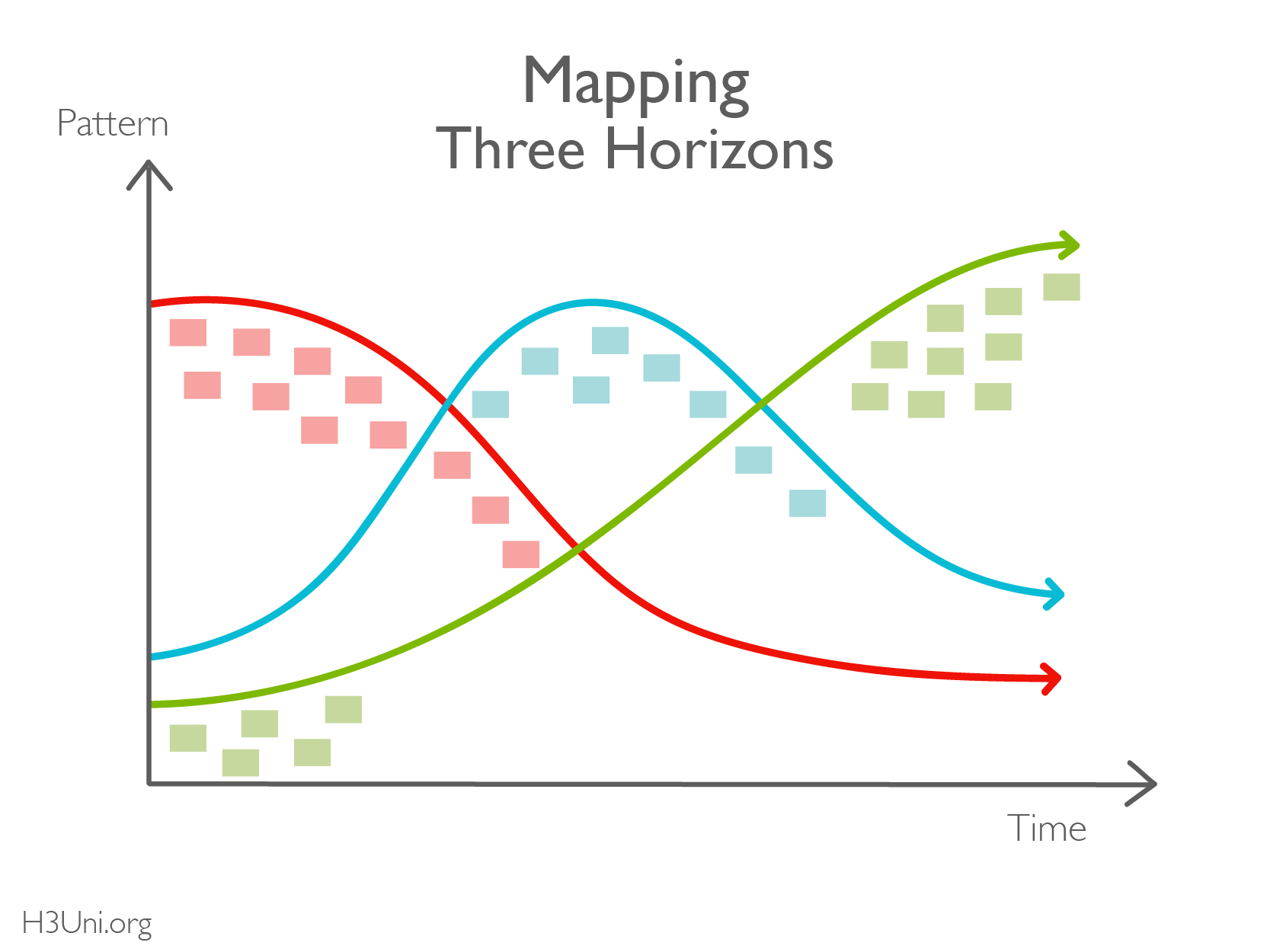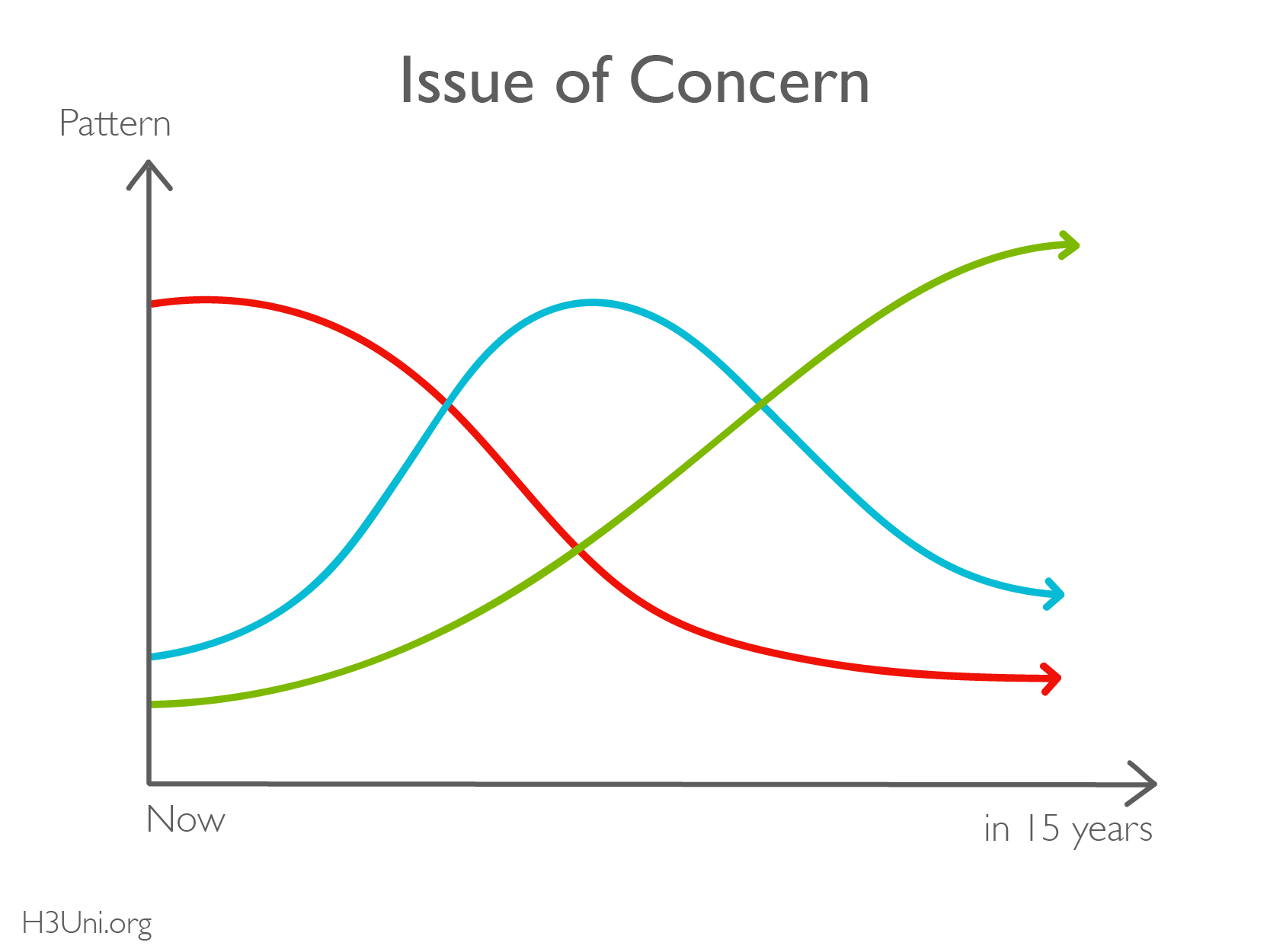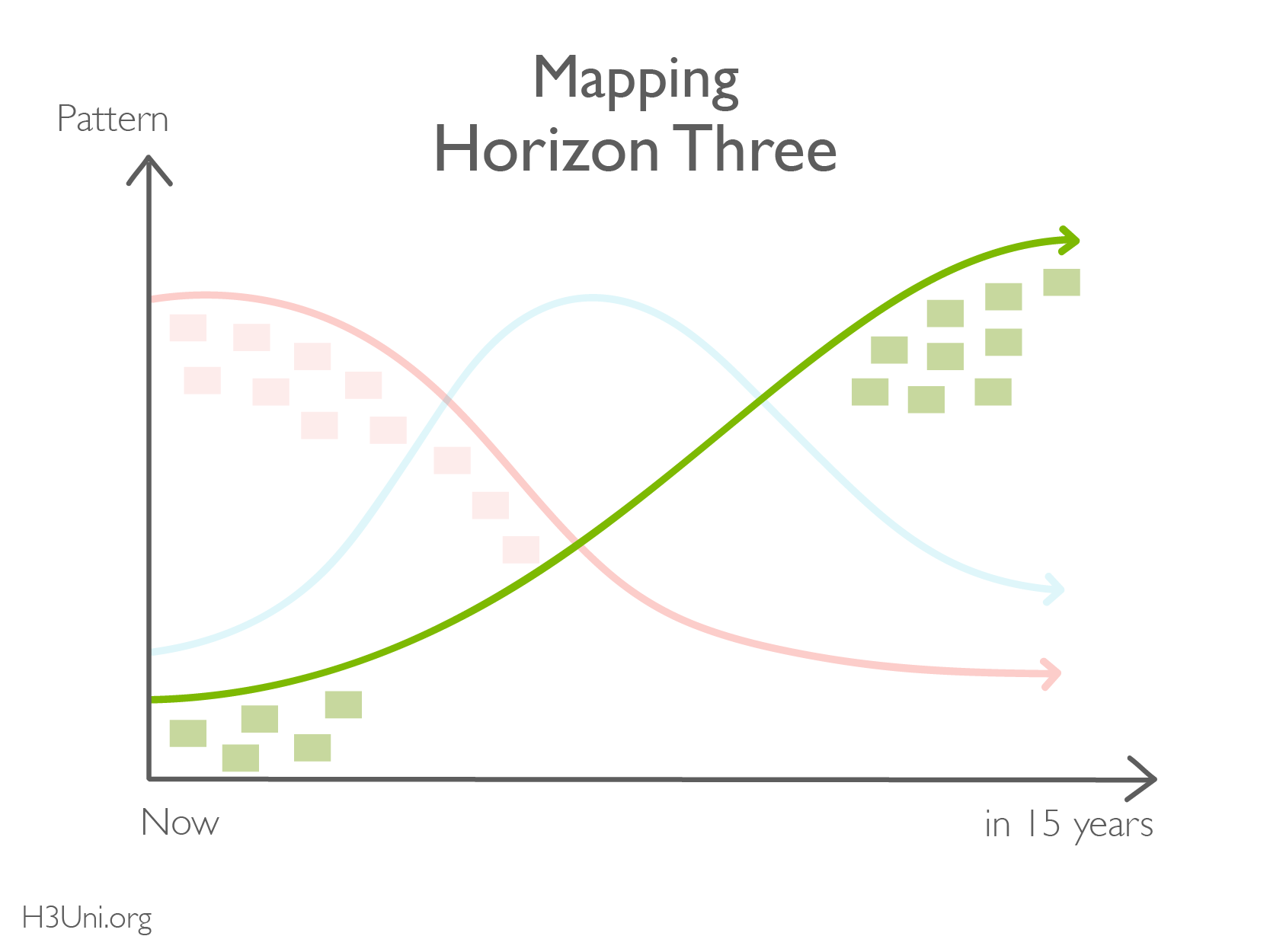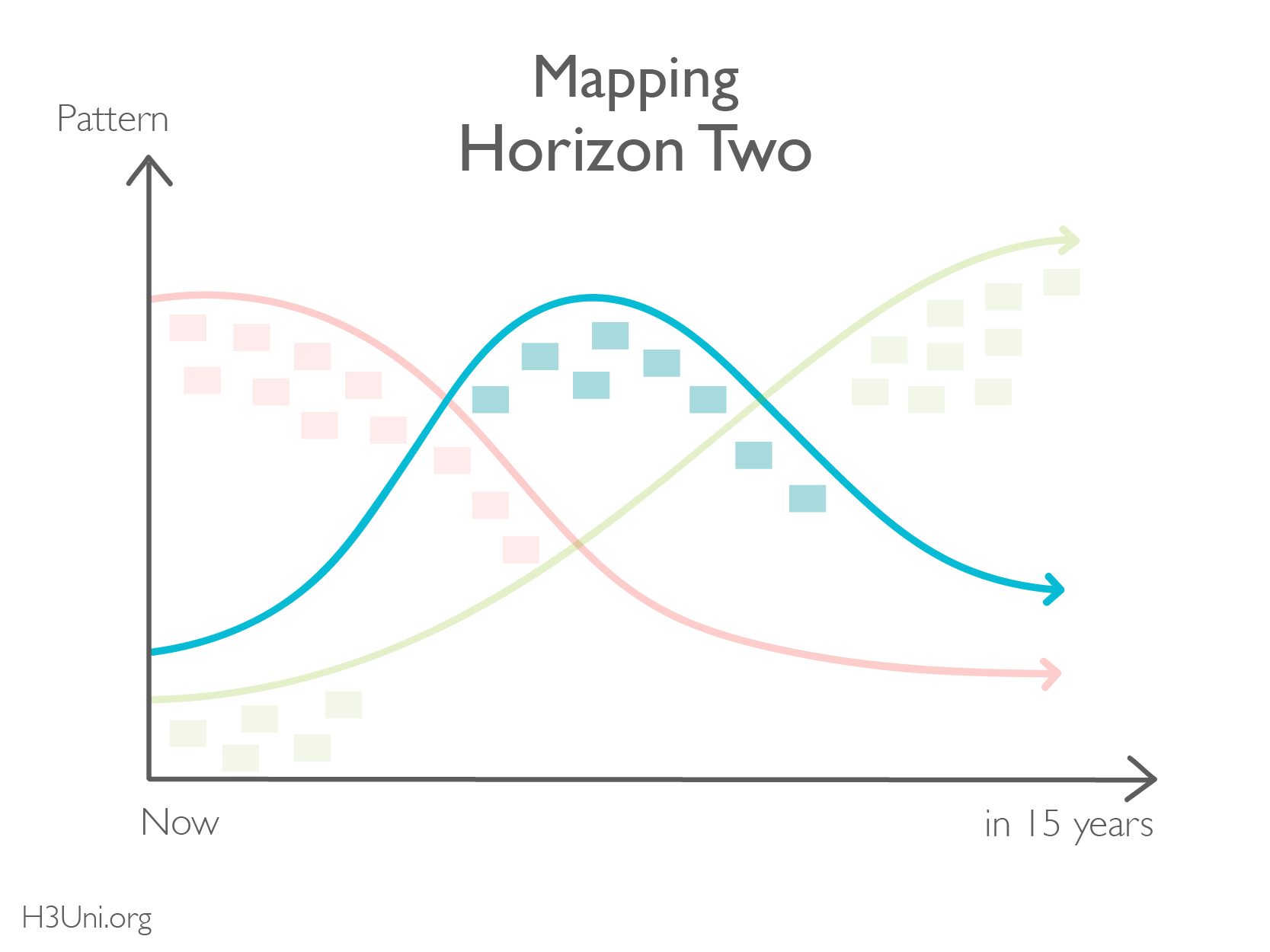Facilitation Guide
Three Horizons Mapping
Purpose
To build a Three Horizon sense-making map of an issue of concern in a way relevant to formulating visionary action for innovation and transformation.
When to use?
This is a basic method that can be used without prior sessions, assuming that the group convenes itself with a shared motivation and sense of the scope of enquiry, or has a leader who can set up the scope of the conversation. The scope and purpose need to have been agreed, at least in draft form, before the session is convened – see Scoping. It is intended as the first phase of a two stage process. The purpose of this stage is sense-making and moving out of horizon mindsets into the three horizon perspectives of futures consciousness. Stage 2 is Three Horizons Action Planning. These are normally separate sessions with some time between, even if just a break in the day. Optionally you can also insert the Three Horizons Multi-Actor Mapping method between stages 1 and 2 in order to broaden the understanding from the perspective of other actors.
Set Up
A Three Horizon chart drawn in the three usual colours of H1 – red, H2 – blue, H3 – green. A1 landscape, or two side-by-side A1 in portrait is big enough for a group of around 6 people who can all be close to it. Small square stickies can be used. A small group can work with a chart laid out on a circular table, though it is always better if everyone can see it easily in front of them. Don’t attempt to use a single flip chart in portrait – this will not provide enough space. For larger groups you need to create a bigger Three Horizons chart so that you can write on rectangular stickies or hexagons that everyone can see. Three flip charts side by side is usually enough. There is not usually enough space to use hexagons for this stage, but it is OK to use rectangular stickies and then use hexagons to capture cluster names and explore the overall map in the Action Planning stage. It helps participants, and improves capture, if you have three different sticky colours for the three horizons (they don’t have to match the horizon colours), but this is not essential. A voice recorder for the final story telling.
Outputs
The diagram shows a typical output of a three horizon session. Each coloured stickie has been generated by a member of the group. They have been positioned according to their dominant role in the waves of change. Their position is not final but an initial basis for telling stories of the future and developing a future consciousness. The vertical line represents the kind of performance of interest and the horizontal line the passage of time into the future. 
Steps
This diagram shows where to map participant answers to questions for steps 1-3. Your exact questions may vary depending on the focus and scope of the exercise. 
Step 1: Scope the Conversation
- Introduce the session as exploring the issue of concern using Three Horizons
- Give a brief explanation of 3H as a sense-making framework for conversation that lets them work with an outward oriented understanding of the world and an inward oriented understanding of their own intentions for change.
- Highlight the idea of the three horizons as three voices in the room, and the intent to move out of our mindsets into a more flexible perspective.
- Summarise the process as visiting the three horizons and then reviewing the processes of change. Make clear whether there is to be a follow-up for moving to action.
- Review the scoping statement for the conversation and ensure it is agreed. Write it up in an agreed form on a flip chart to one side, and label the 3H map with the scope and the time horizon.
Step 2: Explore Horizon 1
- Possible trigger question: “What evidence do you see around you that suggests the current system is under strain, shows a decreasing fit to the emerging conditions, knowledge, and societal requirements, or is even failing?”
- Keep capturing points until the energy drops, or you sense that there is a good enough coverage of the issues.
- Often the participant statements of H1 are criticisms, but lead from there into a statement of how H1 is failing, or failing to respond to conditions.
- Sometimes, it is good to use or add the trigger question: “What is holding the current system in place?”
Step 3: Explore Horizon 3
Possible trigger questions:
- “What might a future system look like and what values and norms would support it?”
- “What long term trends are driving towards these changes?”
- “What examples (from anywhere in the world) do you know about where elements of the future systems you have described already exist? (pocket of the future in the present)”; “
- What is your vision of the emerging future?”
- The role of the facilitator is key to ensuring this part of the conversation balances the outward oriented view of what is going on in the world at large with the vision and aspirations of the group. There is no ‘right’ way to achieve this balance except through experience. Some general approaches:
- Allow aspirational statements, but also ensure that real attention is paid to evidence of change, and sources of alternate visions. The simplest way to handle this is to take every aspirational statement as it comes up and enquire “do we see any body out there trying to do this, any evidence of visionary intent, or pressure to make this change?”. This can usually bring out an example that can then be put into H3 pocket of the future, H2 innovation, or those who are communicating an H3 vision.
- Keep in mind the Scoping diagram and refer back to it – probing for the the visions and aspirations of actors in the transactional and contextual space in order to reveal what sort of H3 they aspire to in their visions. Keep reminding them that the visions of others are evidence of the future they might bring about.
- Try to identify particular actors who might be “tone-setters” and explore what future they might bring about. This can be used as the basis of a separate step in the process – see Three Horizons Multi-Actor Mapping.
- Prepare by immersing yourself in the area through reading/interviews/browsing etc. so that you have some useful probe questions to open up the exploration.
- Think in terms of patterns, and lead discussions to look for systemic sources of change
- Look for overarching inevitables and pre-determineds – sources of change that are building up over the long term that will eventually force change, even though the consequences are unclear. Some things get clearer the further out you look.
- Don’t allow abstract or generic statements such as “more customer focus”, but get to something that is specific.
- Overall, pay attention to weak signals at the margin of the H1 mainstream.
- Value uncertainty, ambiguity, and difference of perspective. When people take strongly differing views then remind them that if reasonable people disagree over something it is uncertain. Find a way to capture the alternate views on the map and move on.
Step 4: Explore Horizon 2
Possible trigger question: “What innovations do you know about (anywhere in the world) that are responding to the pressures for change and might be growth points of the future system?”
- Don’t use this as a an ideation or brainstorm – generating innovative steps forward comes in action planning. Insist that H2 can only be populated with real actors doing real things that the group knows about – not with visions or aspirations, or statements of trends. As these come up try to get a sense of whether they are H2+ or H2- and place them appropriately. Ask questions to clarify what the actor is doing and where they seem to be heading.
Step 5: Tell a story of the map
- Telling the big picture at the end of a 3H session helps groups gain a sense of closure and helps them see how their discussions fit into a larger pattern. You need to judge whether to offer the group a story from your position as facilitator, helping them see the story they’ve told, or (better) get one of them to tell it. It can help to take the pressure off if you describe it as ‘the plot of a B-movie’ – just a rough draft of a story that could be worked up.
- From your position as facilitator, lead a discussion of the dynamics of change that the map is revealing.
- Use big stickies to capture some of the overall dynamics of change.
- Invite someone to tell the story.
- It is a good idea to audio record story-telling and transcribe it for the group. The first telling often has a clarity and conviction that is hard to recover afterwards. There is a surprising richness in the story that is not always apparent in the moment and is lost if not fully captured.
How to Tell a 3H Story
- If the facilitator is telling the story it happens in two steps: 1) Facilitator tells the story, 2) The group shares missing points which are added to the main map. If the team are doing it then just suggest the overall structure using Step 1, and then invite them to develop the story and have someone volunteer to tell it.
- Step 1: Inviting everyone to come near the main 3H map, the facilitator says:
- “We imagine that we are in the future when this 3rd horizon is now the present. We ask ourselves ‘How did we get here?’
- In 2015 we were having these issues – H1 Story
- There were promising signs – (early H2 & H3) which were pockets of the future in the present
- This started to stimulate innovation – H2 Story (ambiguity of H2+/-)
- Because they worked, here we are now and we have a society that… H3 Story”
- Step 2: The facilitator asks if anything is missing from the wall.
- Facilitated group discussion is encouraged to get multiple perspectives and a variety of topics.
- The essence of the points are captured by the facilitator or supporter, and they are added to the appropriate horizon.
- In some cases, if someone raises a 3H point, feel free to ask the group if there are any ideas on innovation to achieve it, vice versa, and record it on the map.
This story telling might fit in at various points in the process, depending on the overall project flow.
Tips
Process
- A useful conversation needs 90 mins to 2 hours. This allows time to stand back from collecting input and spend time on the final sense-making step.
- It takes sustained attention on the part of the facilitator to keep a good pace to the conversation, without it getting hung up on one point or running off into an uncontrolled brainstorm. Use the visual facilitation techniques to take points one at a time, with careful capture and confirmed understanding. Don’t let any point go on for more than a few minutes.
- Look back to look forward: Optionally, get the group to look back as far as you want to look forward. Before doing H1, look back and ask where did H1 come from. This helps tune in to the timescales over which different change processes are running.
People
- How you set up the conversation is critical to the way people will engage in it. What you want to encourage is a conversation that is open-ended, inclusive and safe for people to participate in, and where participants feel they can share their real aspirations and concerns. It will help to reassure them that there is no right answer, the conversation is not supposed to reach a conclusion, diversity of views is a resource not a problem, and that you (and any colleagues supporting you, e.g. as a note-taker) will manage everything. Their only role is to participate in the conversation as freely as possible.
- The dynamics of the conversation will be highly dependent on the mix of horizon participants in the room, and how well they know each other. Make explicit use of the three horizons perspectives chart to bring out the positive contribution of the different horizon perspectives if people drop into mindsets – this can usually be made humorous and fun once people realise how they identify with one horizon.
- People need to stay in an exploratory divergent/emergent thinking style and some people are uncomfortable with this. Acknowledge this possible discomfort, and make clear that they will move into a convergent style in the second phase when they move to action planning.
Thinking
- People naturally want to talk about their own organisation and goals. It takes effort on the part of the facilitator to ensure that the discussion engages with the world beyond the organisation. Use the scoping statement to keep them paying attention to what is going on “out there”, where the visible actions and intentions of others are evidence of unfolding futures.
Links to resoures
- The International Futures Forum provides downloadable resources, including a Three Horizons Kit http://www.iffpraxis.com/3h-resources.
![]()
Creative Commons Attribution-ShareAlike 4.0 International (CC BY-SA 4.0) license framework.
How to Use this License
CC BY-BY-SA
This license allows reusers to distribute, remix, adapt, and build upon the material in any medium or format, so long as attribution is given to the creator. The license allows for commercial use. If you remix, adapt, or build upon the material, you must license the modified material under identical terms.
Read about Open Access to H3Uni Methods and Materials



